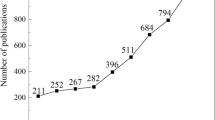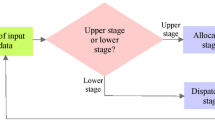Abstract
In this paper, we studied a substage-zoning filling design problem, which is considered as a complex problem with numerous tasks such as construction planning, dam access road and borrow placement, workspace filling, and construction project management. In analyzing workflows and the mechanism of substage-zoning filling, not only the above-mentioned tasks are considered, but also the environmental factors such as rainfall and hydrology characteristic temperature are taken into account. In this study, an optimization model for dam filling which aimed at reducing the disequilibrium degree of filling intensity was proposed; in addition, a technique based on particle swarm optimization was introduced as the basis of a decision support system for rock-fill dams. The system has been employed in a water conservancy and hydropower project which shows that the system is able to provide quality decision support and facilitate the rock-fill dam construction effectively.





Similar content being viewed by others
References
Zhang Y, Xia G (2009) Construction of high embankment dam material flow equilibrium system. Expert Syst Appl 36(5):9175–9191
Huang J, Wang D (2004) Research on staged-filling scheme about concrete-faced rock-fill dam of Hongjiadu hydropower station. Yangtze River 35(7):1–5
Ozkan M (1998) A review of considerations on seismic safety of embankments and earth and rock-fill dams. Soil Dyn Earthquake Eng 17(7–8):439–458
Cetin H, Laman L, Ertunç A (2000) Settlement and slaking problems in the world’s fourth largest rock-fill dam, the Ataturk Dam in Turkey. Eng Geol 56(3–4):225–242
Li S, Qin X (2005) The scheme for dam body fill and access roads to dam ccr arrangement of the Nuozhadu Hydropower Station. Water Power 31(5):66–71
Warfield JN (2007) Systems science serves enterprise integration: a tutorial. Enterp Inform Syst 1(2):235–254
Xu L (2000) The contribution of systems science to information systems research. Syst Res Behav Sci 17:105–116
Piao C, Han X, Wu H (2010) Research on e-commerce transaction networks using multi-agent modelling and open application programming interface. Enterp Inform Syst 4(3):329–353
Kannan G, Matinez J, Vorster M (1997) A framework for incorporating dynamic strategies in earth-moving simulations. Proceedings of the 29th conference on Winter simulation. Atlanta, Georgia, pp 1119–1126
Zhang W, Lin Y (2010) On the principle of design of resilient systems-application to enterprise information systems. Enterp Inform Syst 4(2):99–110
Zhang W (2010) Guest ediror’s foreword. Enterp Inform Syst 4(2):95–97
Erol O, Sauser B, Mansouri M (2010) A framework for investigation into extended enterprise resilience. Enterp Inform Syst 4(2):111–136
Liu D, Deters R, Zhang W (2010) Architectural design for resilience. Enterp Inform Syst 4(2):137–152
Capozucca A, Guelfi N (2010) Modelling dependable collaborative time-constrained business processes. Enterp Inform Syst 4(2):153–214
Wang J, Gao F, Ip W (2010) Measurement of resilience and its application to enterprise information systems. Enterp Inform Syst 4(2):215–223
Xu L (1988) A fuzzy multi-objective programming algorithm in decision support systems. Ann Oper Res 12:315–320
Xu L (1994) A decision support system for aids intervention and prevention. Int J Biomed Comput 36:281–291
Feng S, Xu L (1997) An integrated knowledge-based system for urban planning decision support. Knowl-Based Syst 10:103–109
Xu L, Li L (2000) A hybrid system applied to epidemic screening. Expert Syst 17:81–89
Xu L, Liang N, Gao Q (2008) An integrated approach for agricultural ecosystem management. IEEE Trans Syst Man Cybern Part C 38(2):1–10
Xu L, Tan W, Zhen H, Shen W (2008) An approach to enterprise process dynamic modeling supporting enterprise process evolution. Inform Syst Front 10(5):611–624
Feng S, Xu L (1999) Decision support for fuzzy comprehensive evaluation of urban development. Fuzzy Sets Syst 105(1):1–12
Ogryczak W, Studzinski K, Zorychta K (1992) DINAS: a computer-assisted analysis system for multiobjective transshipment problems with facility location. Comput Oper Res 19(7):637–647
Zhao H, Zhang Y, Wang Z, Lee S, Kwong W (2003) Research on group decision support system for concurrent product development process. J Mater Process Technol 139(1–3):619–623
Xu L, Li Z, Li S, Tang F (2007) A decision support system for product design in concurrent engineering. Decis Support Syst 42(4):2029–2042
Xu L, Li Z, Li S, Tang F (2005) A polychrommatic sets approach to the conceptual design of machine tools. Int J Prod Res 43(12):2397–2422
Hastak M, Thakkallapalli S (2004) Decision model for assessment of underground pipeline rehabilitation options. Urban Water J 1(1):27–37
Kumaraswamy M, Dissanayaka S (2001) Developing a decision support system for building project procurement. Build Environ 36(3):337–349
Zavadskas E, Kaklauskas A, Vainiûnas P, Turski P (2003) Efficiency increase of internet based information systems in real estate sector by applying multiple criteria decision support systems. J Civ Eng Manag 9:83–90
Zeng J, Wang L, Wang T, Fan W, Gao H (2009) Particle swarm optimization-based machine arrangement for filling construction of rock-fill dams. IEEE International Conference on Industrial Engineering and Engineering Management, Hong Kong, pp 1772–1775
Al-Khaiat H, Fereig S (1996) The role of precast concrete systems in Kuwaiti housing projects–In-depth analysis of Kuwaiti precast concrete industry-Advantages and limitations of each system outlined. Build Res Inform 24(6):374–378
Jackie R, Gary K (2002) Evolution in groups: a genetic algorithm approach to group decision support systems. Inf Technol Manage 3(3):213–227
Luo J, Xu L, Jamont J, Zeng L, Shi Z (2007) Flood decision support system on agent grid: method and implementation. Enterp Inform Syst 1(1):49–68
Feng S, Li L, Duan Z, Zhang J (2007) Assessing the impacts of south-to-north water transfer project with decision support systems. Decis Support Syst 42(4):1989–2003
Zhou S, Xu L (1999) Dynamic recurrent neural networks for a hybrid intelligent decision support system for the metallurgical industry. Expert Syst 16(4):240–247
Feng S, Xu L (1996) A hybrid knowledge-based system for urban development. Expert Syst Appl 10(1):157–163
Feng S, Xu L (1996) Integrating knowledge-based simulation with aspiration-directed model-based decision support system. Syst Eng Electron 7(2):25–33
Xu L (1987) Toward escape from the limitations of systems analysis: introduction of dimensionality. Syst Res 4:243–250
Feng W, Qu W, Xie H (2002) A note on the stresses of the ship lock of the Gezhouba project. J Mater Process Technol 123(2):241–244
Wang L, Xu L, Wang X, You W, Tan W (2009) Knowledge portal construction and resources integration for a large scale hydropower dam. Syst Res Behav Sci 26(3):357–366
Wang R, Liu J, Li S (2008) Optimization model for substage-zoning filling design of high core rock-fill dams. China Civ Eng J 41(2):105–110
Kutzner C (1989) Earth and rock-fill dams: principles of design and construction. Taylor & Francis, Netherlands
Jansen R (1988) Advanced dam engineering for design, construction and rehabilitation. Springer, New York
Goodman R (1989) Introduction to rock mechanics. Wiley, New York
Kennedy J, Eberhart R (1995) Particle swarm optimization. Proceeding of IEEE international conference on neural networks. Piscataway, USA, pp 1942–1948
Tao F, Zhang L, Lu K, Zhao D (2011) Research on manufacturing grid resource service optimal-selection and composition framework. Enterprise information systems first published on: 02 February 2011 (iFirst) doi:10.1080/17517575.2010.540677
Yu W, Li R (2002) Study based on genetic glgorithms fot constrained optimization. Comput Sci 29(6):98–101
Wilke D, Kok S, Groenwold A (2006) Comparison of linear and classical velocity update rules in particle swarm optimization: notes on diversity. Int J Numer Methods Eng 70(8):962–984
Vlachogiannis J, Lee K (2009) Multi-objective based on parallel vector evaluated particle swarm optimization for optimal steady-state performance of power systems. Expert Syst Appl 36(8):10802–10808
Acknowledgments
The authors acknowledge the support of the National Natural Science Foundation of China (Grant No 70971005), the Ministry of Science and Technology of China (Grant No 2006BAK04A23), Quality Inspection Project: Current State Analysis and Strategy Research about Consumer Products on Inspection and Testing Methods (Grant No 200910088) and Changjiang Scholars Program of the Ministry of Education of China.
Author information
Authors and Affiliations
Corresponding author
Rights and permissions
About this article
Cite this article
Wang, L., Zeng, J. & Xu, L. A decision support system for substage-zoning filling design of rock-fill dams based on particle swarm optimization. Inf Technol Manag 12, 111–119 (2011). https://doi.org/10.1007/s10799-011-0092-7
Published:
Issue Date:
DOI: https://doi.org/10.1007/s10799-011-0092-7




